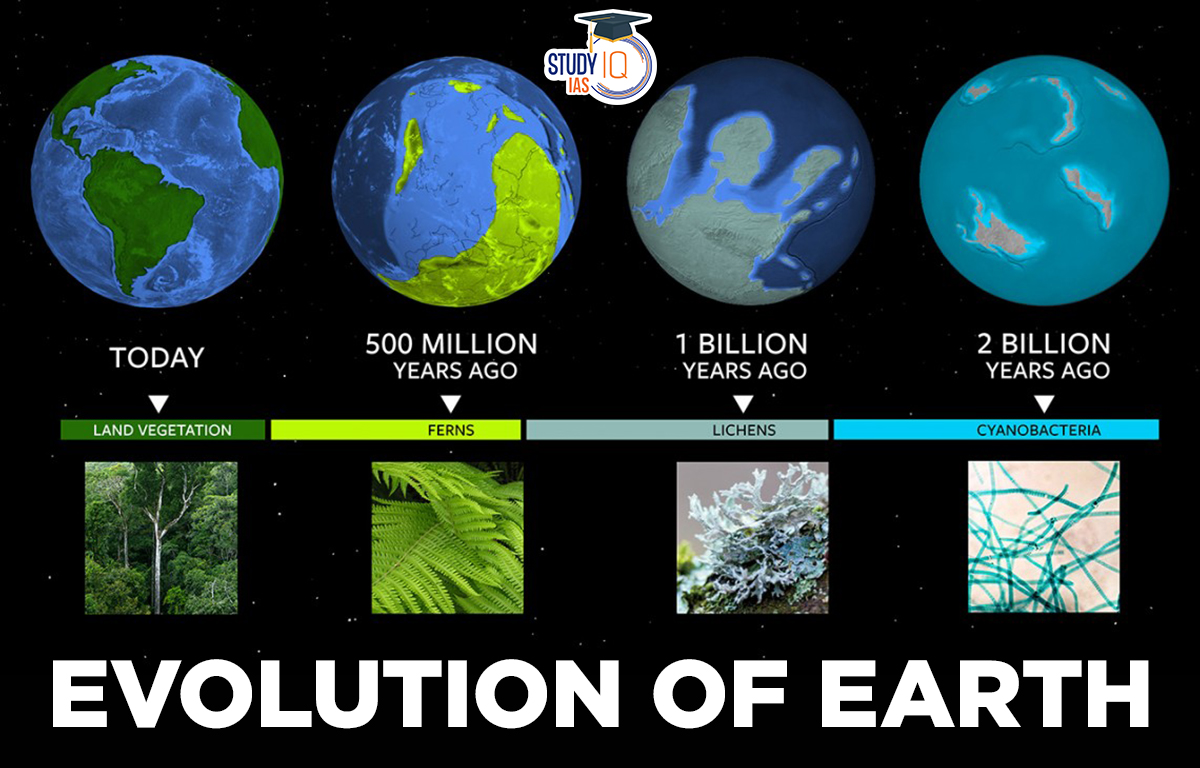Table of Contents
Evolution of Earth
“Evolution” means the change of living things over time, but it also refers to how planets, stars, galaxies, and the universe change. Earth began as a hot, rocky place with a thin atmosphere of hydrogen and helium. Over 4.6 billion years, it developed life, water, and a supportive atmosphere. Earth has layers, each made of different materials, with the atmosphere being the least dense.
In the late 1920s, astronomer Edwin Hubble found that distant stars and galaxies are moving away from Earth. The farther they are, the faster they move, which shows that the universe is expanding. This suggests that the universe started as a smaller, denser point, and then expanded after a big explosion known as the Big Bang.
Evolution of Earth, which is covered in this article, is covered in the Geography of UPSC Syllabus. Students can also go for UPSC Mock Test to get more accuracy in their preparations.
Evolution of Earth & Earlier Theories
Nebular Theory or Nebular Hypothesis
In the past, scientists and philosophers had different ideas about how the world evolved. One idea came from German philosopher Immanuel Kant, later improved by mathematician Laplace. They believed that planets, including Earth, formed from a cloud called a nebula and changed over time. In 1900, Chamberlain and Moulton suggested that planets formed from smoke created by a star near the sun. As the solar system moved, these smoke balls slowly came together to form planets. This idea was strongly supported by Sir James Jeans and Sir Harold Jeffrey.
Binary Theories
In the 1950s, the Binary theories suggested that the sun had a companion made of hydrogen and helium. These elements along with particles called “dust,” helped form the planets. This idea was presented by Otto Schmidt from Germany and Karl Weizsäcker from Russia.
Evolution of Earth & Modern Theories
The Big Bang Theory
Edwin Hubble’s “Expanding Universe Hypothesis” shows that the universe is expanding and will continue to do so. This idea is based on the “Big Bang Theory.” It’s like balloons expanding next to each other, with the space between them growing. According to this hypothesis, the universe started as a ball of matter that exploded to create what we see today. This process took about 13.7 billion years. After about 300,000 years, the matter formed the current shape of the universe. In contrast, Hoyle’s theory suggested that the universe has always been stable, which is different from Hubble’s idea.
Star Formation
In different parts of the universe, there were different gravitational forces. This caused various types of matter to come together and form galaxies. A galaxy has many stars, and the distance between them is measured in light-years.
Planet’s Formation
There were several stages in the formation of the planets:
- Gases make up the majority of stars.
- A gas cloud results from their assemblage.
- Around the gas core, dust forms.
- Smaller round objects known as planetesimals are created by the condensing of this matter, and after these objects collide and eventually cling together, planets, which are larger than planets, are created.
Evolution of Earth in Various Forms
Evolution of Lithosphere
- In its early days, Earth was very unstable and hot.
- As it got denser, the temperature inside increased, causing materials to separate by weight.
- Heavy materials like iron sank to the center, while lighter ones moved to the surface, forming the crust.
- Over time, Earth cooled, solidified, and shrank in size, creating a solid outer crust.
- The giant impact that formed the moon also heated Earth further.
- This process, called differentiation, separated Earth into layers: crust, mantle, outer core, and inner core, with density increasing towards the center.
Evolution of Atmosphere & Hydrosphere
- Atmosphere: Mainly composed of nitrogen and oxygen.
- Evolution Stages: Three stages – loss of primordial atmosphere, contributions from Earth’s interior, and modification by photosynthesis.
- Primordial Atmosphere: The early atmosphere with hydrogen and helium was stripped away by solar winds.
- Degassing: Gases and water vapor released from Earth’s interior during cooling, leading to the current atmosphere.
- Formation of Oceans: Water vapor condensed, forming oceans within 500 million years of Earth’s formation.
- Photosynthesis and Oxygen: Photosynthesis began around 2500-3000 million years ago, eventually saturating oceans with oxygen and flooding the atmosphere 2,000 million years ago.
Evolution of Earth UPSC
The Earth’s evolution is a crucial subject for the Civil Services exam. Aspirants can glance at the significant details that will cover the complete Geography curriculum by looking at the Geography Notes for UPSC. Students can read all the details related to UPSC by visiting the official website of StudyIQ UPSC Online Coaching.


 DRDO and Air Force Successfully Test Ind...
DRDO and Air Force Successfully Test Ind...
 IB ACIO Recruitment 2025 Notification Ou...
IB ACIO Recruitment 2025 Notification Ou...





















